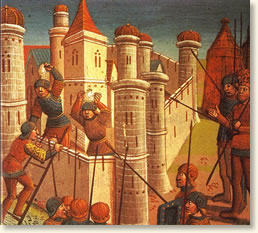The Sack of Constantinople, 1453
The Destruction of the Last Vestige of the Roman Empire
The ancient city of Constantinople, located in modern Turkey and today known as Istanbul, was founded by the Roman Emperor Constantine in 330 who made it the seat of his reign. When the western portion of the Roman Empire disintegrated in the fifth century (see The Fall of Rome) Western Europe was propelled into the Dark Ages. However, vestiges of the glory of the Roman Empire lived on in the city-state of Constantinople for over one thousand years.
By the middle of the fifteenth century, the prominence of Constantinople and the Byzantine Empire that it ruled had suffered a dramatic decline. The city found itself entirely surrounded by an Ottoman Empire eager to expand its domain. The final blow came in the spring of 1453 when the Ottoman Turks, led by the Sultan Mehmed II, besieged the city for fifty-seven days. On May 29 the Sultan led an over-whelming force that successfully breached the walls of the city and proceeded to massacre the citizenry. Following his victory, the Sultan moved the Ottoman capital from Adrianople to Constantinople. The last vestige of the ancient Roman Empire was no more.
An observer describes the scene:
"Nothing will ever equal the horror of this harrowing and terrible spectacle. People frightened by the shouting ran out of their houses and were cut down by the sword before they knew what was happening. And some were massacred in their houses where they tried to hide, and some in churches where they sought refuge.
 |
A contemporary depiction
of the battle
|
The enraged Turkish soldiers . . . gave no quarter. When they had massacred and there was no longer any resistance, they were intent on pillage and roamed through the town stealing, disrobing, pillaging, killing, raping, taking captive men, women, children, old men, young men, monks, priests, people of all sorts and conditions . . . There were virgins who awoke from troubled sleep to find those brigands standing over them with bloody hands and faces full of abject fury. This medley of all nations, these frantic brutes stormed into their houses, dragged them, tore them, forced them, dishonored them, raped them at the cross-roads and made them submit to the most terrible outrages. It is even said that at the mere sight of them many girls were so stupefied that they almost gave up the ghost.
Old men of venerable appearance were dragged by their white hair and piteously beaten. Priests were led into captivity in batches, as well as reverend virgins, hermits and recluses who were dedicated to God alone and lived only for Him to whom they sacrificed themselves, who were dragged from their cells and others from the churches in which they had sought refuge, in spite of their weeping and sobs and their emaciated cheeks, to be made objects of scorn before being struck down. Tender children were brutally snatched from their mothers' breasts and girls were pitilessly given up to strange and horrible unions, and a thousand other terrible things happened. . .
Temples were desecrated, ransacked and pillaged . . . sacred objects were scornfully flung aside, the holy icons and the holy vessels were desecrated. Ornaments were burned, broken in pieces or simply thrown into the streets. Saints' shrines were brutally violated in order to get out the remains which were then thrown to the wind. Chalices and cups for the celebration of the Mass were set aside for their orgies or broken or melted down or sold. Priests' garments embroidered with gold and set with pearls and gems were sold to the highest bidder and thrown into the fire to extract the gold. Immense numbers of sacred and profane books were flung on the fire or tom up and trampled under foot. The majority, however, were sold at derisory prices, for a few pence. Saints' altars, tom from their foundations, were overturned. All the most holy hiding places were violated and broken in order to get out the holy treasures which they contained . . .
When Mehmed (II) saw the ravages, the destruction and the deserted houses and all that had perished and become ruins, then a great sadness took possession of him and he repented the pillage and all the destruction. Tears came to his eyes and sobbing he expressed his sadness. 'What a town this was! And we have allowed it to be destroyed'! His soul was full of sorrow. And in truth it was natural, so much did the horror of the situation exceed all limits."
References:
This eyewitness account appears in: Routh, C. R. N. They Saw It Happen in Europe 1450-1600 (1965).
How To Cite This Article:
"The Sack of Constantinople, 1453" EyeWitness to History, www.eyewitnesstohistory.com
(2011).
|






